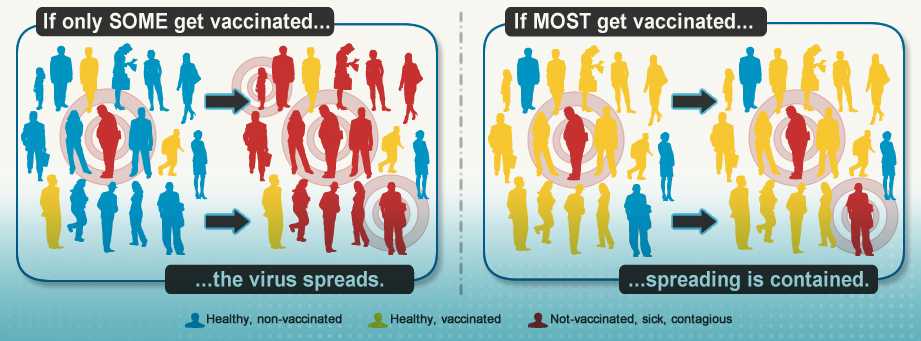What Would Happen If We Stopped Vaccinations?
Before the middle of the last century, diseases like whooping cough, polio, measles, Haemophilus influenzae, and rubella struck hundreds of thousands of infants, children and adults in the U.S.. Thousands died every year from them. As vaccines were developed and became widely used, rates of these diseases declined until today most of them are nearly gone from our country.
- Nearly everyone in the U.S. got measles before there was a vaccine, and hundreds died from it each year. Today, most doctors have never seen a case of measles.
- More than 15,000 Americans died from diphtheria in 1921, before there was a vaccine. Only two cases of diphtheria have been reported to CDC between 2004 and 2014.
- An epidemic of rubella (German measles) in 1964-65 infected 12½ million Americans, killed 2,000 babies, and caused 11,000 miscarriages. Since 2012, 15 cases of rubella were reported to CDC.
Given successes like these, it might seem reasonable to ask, “Why should we keep vaccinating against diseases that we will probably never see?” Here is why:
Vaccines don't just protect yourself.
Most vaccine-preventable diseases are spread from person to person. If one person in a community gets an infectious disease, he can spread it to others who are not immune. But a person who is immune to a disease because she has been vaccinated can’t get that disease and can’t spread it to others. The more people who are vaccinated, the fewer opportunities a disease has to spread.

If one or two cases of disease are introduced into a community where most people are not vaccinated, outbreaks will occur. In 2013, for example, several measles outbreaks occurred around the country, including large outbreaks in New York City and Texas – mainly among groups with low vaccination rates. If vaccination rates dropped to low levels nationally, diseases could become as common as they were before vaccines.
Top of PageDiseases haven't disappeared.
The United States has very low rates of vaccine-preventable diseases, but this isn’t true everywhere in the world. Only one disease — smallpox — has been totally erased from the planet. Polio is close to being eliminated, but still exists in several countries. More than 350,000 cases of measles were reported from around the world in 2011, with outbreaks in the Pacific, Asia, Africa, and Europe. In that same year, 90% of measles cases in the U.S. were associated with cases imported from another country. Only the fact that most Americans are vaccinated against measles prevented these clusters of cases from becoming epidemics.
 Disease rates are low in the United States today. But if we let ourselves become vulnerable by not vaccinating, a case that could touch off an outbreak of some disease that is currently under control is just a plane ride away.
Disease rates are low in the United States today. But if we let ourselves become vulnerable by not vaccinating, a case that could touch off an outbreak of some disease that is currently under control is just a plane ride away.
A final example: what could happen.
We know that a disease that is apparently under control can suddenly return, because we have seen it happen, in countries like Japan, Australia, and Sweden. Here is an example from Japan. In 1974, about 80% of Japanese children were getting pertussis (whooping cough) vaccine. That year there were only 393 cases of whooping cough in the entire country, and not a single pertussis-related death. Then immunization rates began to drop, until only about 10% of children were being vaccinated. In 1979, more than 13,000 people got whooping cough and 41 died. When routine vaccination was resumed, the disease numbers dropped again.
The chances of your child getting a case of measles or chickenpox or whooping cough might be quite low today. But vaccinations are not just for protecting ourselves, and are not just for today. They also protect the people around us (some of whom may be unable to get certain vaccines, or might have failed to respond to a vaccine, or might be susceptible for other reasons). And they also protect our children’s children and their children by keeping diseases that we have almost defeated from making a comeback. What would happen if we stopped vaccinations? We could soon find ourselves battling epidemics of diseases we thought we had conquered decades ago.
References
- CDC. Measles — United States, January 1-August 24, 2013. MMWR 2013; 62(36);741-43.
- Updates on CDC’s Polio Eradication Efforts
- Reported Cases and Deaths from Vaccine Preventable Diseases, United States, 1950-2013 [6 pages]
- Gangarosa EJ, et al. Impact of anti-vaccine movements on pertussis control: the untold story [6 pages] . Lancet 1998;351:356-61.
Related Pages
- Page last reviewed: March 10, 2017
- Page last updated: March 10, 2017
- Content source:


 ShareCompartir
ShareCompartir